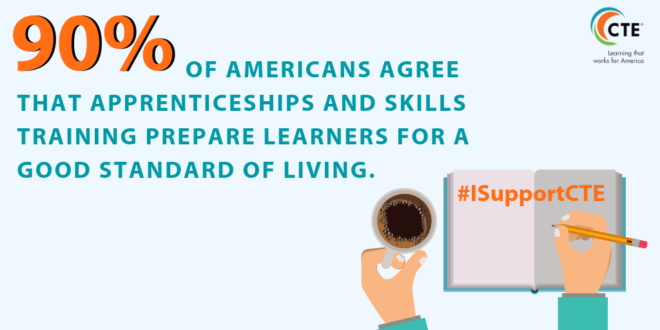Encourage the Federal Government to Double Their Funding
Career Technical Education (CTE) provides middle school, high school, postsecondary, and adult learners with the knowledge and skills they need to be prepared for successful careers. Learners enrolled in CTE programs progress along a pathway of increasingly specific academic and technical courses. They often have the opportunity to participate in internships, engage with employers, and apply what they are learning through hands-on projects.
Funding for CTE supports a
• Professional development for teachers and faculty to remain up to date on the latest industry advances;
• Career counseling, guidance, and advisement;
• Career exploration opportunities;
• Creation of new programs and associated equipment;
• Improvement and expansion of
• Building
Across the country, CTE programs are preparing learners for promising careers and giving employers and our economy a competitive edge. Eighty-six percent of adults concentrating in CTE either continued their education or were employed within six months of completing their program!
• CTE programs provide unique opportunities for learners to engage with employers and participate in internships, apprenticeships, and other meaningful on-the-job experiences. Ninety percent of Americans agree that apprenticeships and skills training programs prepare students for a good standard of living.
• Students involved in CTE are far less likely to drop out of high school than other students, a difference estimated to save the economy $168 billion each year.
With demand for technical skills growing, America needs more funding to expand and improve CTE programs to serve more learners and employers. Seventy-three percent of Americans said increasing federal spending on K–12 public education is extremely important when asked to identify their priorities for the new Congress!
• Nearly 60 percent of companies report having difficulty filling job openings because of a lack of qualified applicants, which can cost a company more than $800,000 each year in lost productivity and recruitment.
• A survey of school districts offering CTE found that the top barrier to offering CTE in high school was a lack of funding or the high cost of the programs.
Expanding funding for CTE programs will create a brighter future for our community—leading to more career options for learners, better results for employers, and increased growth for our economy. Ninety-one percent of parents of students in CTE believe their child is getting a leg up on their career, compared to only 44 percent of parents with children not involved in CTE!
• The high school graduation rate for students with a concentration of CTE courses is 94 percent, about 10 percentage points higher than the national average.
• The estimated impact of a 90 percent graduation rate nationwide (calculated for the class of 2015) is a $5.7 billion increase in economic growth and $664 million in additional federal, state and local taxes.
That is why the CTE community is leading the charge to double the federal investment in programs that work for America. Visit ISupportCTE.org and sign your company or organization on to the Double the Investment in CTE campaign!
 Sprinkler Age A Publication of the American Fire Sprinkler Association
Sprinkler Age A Publication of the American Fire Sprinkler Association

